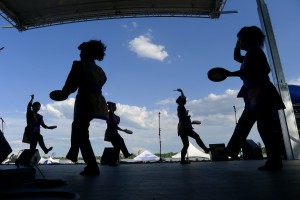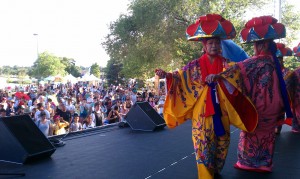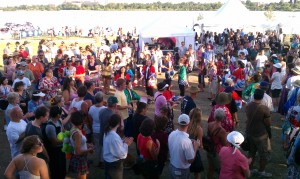02 Aug Why I love the Colorado Dragon Boat Festival
 It struck me towards the end of the first day of the Colorado Dragon Boat Festival that the clash of cultures I had just witnessed perfectly encapsulates why I’ve been a volunteer for this event since it was started in 2001.
It struck me towards the end of the first day of the Colorado Dragon Boat Festival that the clash of cultures I had just witnessed perfectly encapsulates why I’ve been a volunteer for this event since it was started in 2001.
(Full disclosure: Last year, my partner Erin Yoshimura took on the role as executive director of the festival, after volunteering from the beginning. I help out with media, the website and emceeing on the main stage.)
As the first day of the two-day event came to a close, the main stage lineup included a sampling of performers from the festival’s very popular Cultural Unity stage, a showcase of Colorado’s diverse hip-hop community.
The hip-hop sampler was fantastic – and showed why their stage is always so jammed that you can barely see through the crowds surrounding the tent, especially when the dancers are spinning on the ground.
The elevated main stage offered an eye-popping view for the audience, most of whom hadn’t gone by the Cultural Unity area before. The performance was a 20-minute introduction to the artistic principles and driving aesthetics of hip-hop culture, starting with naked rhythm from a conga drum, then showing the evolution of the rhythm into the DJ’s scratching with turntables and vinyl records.
Then the B-boys and B-girls assembled around the stage in a half-circle took turns strutting their stuff to the rhythmic riffing, spinning, flipping and contorting their bodies into unbelievably elastic poses and leaving the audience agog.
The set emphasized the multicultural appeal of hip-hop and pointed out how the performers on stage with him ran the ethnic gamut: Asian, Caucasian, African American, Latino.
Following the Cultural Unity sampler, which drew a huge crowd to the stage, most of the audience stayed for the Colorado Okinawa Kenjinkai, a group of women from Okinawa who preserve the traditional dances of Okinawa, a culture that’s distinct from Japan.
 The group has its own educational mission, to explain that Okinawa was once its own country with its own distinct culture. They demonstrated their lovely, flowing folk dances to the audience, who were still dazzled from the hip-hop set and amazingly open to something completely different. They talked about Okinawan history and explained the differences in language between Japanese and Okinawan.
The group has its own educational mission, to explain that Okinawa was once its own country with its own distinct culture. They demonstrated their lovely, flowing folk dances to the audience, who were still dazzled from the hip-hop set and amazingly open to something completely different. They talked about Okinawan history and explained the differences in language between Japanese and Okinawan.
And though the two sets must have been a culture shock for the audience, the “ah hah!†moment that struck me was that this very dichotomy between tradition and today, between preserving our cultural past and embracing our pop present, is what the Colorado Dragon Boat Festival has crystallized for 11 years.
When the Okinawan group ended its performance to wild applause, and I introduced the day’s finale, a Japanese Bon Odori Dance led by the Denver Buddhist Temple Minyo Kai group, I got all misty eyed. This group performs an Obon dance once a year, at the Sakura Matsuri in downtown Denver’s Sakura Square. Many of the peope who join the dance there are non-Asian but they’re Japanophiles.
The Colorado Dragon Boat Festival is an entirely different audience of Asiaphiles and the merely Asia curious, as well as people who just love a fun family-friendly summertime event. Most of the audience from the hip-hop performance was still in front of the stage and we had them line up in concentric circles in the grass.
 With a little urging, they began following the movements of the Minyo Kai dancers in the middle circle. I saw people having fun, trying new things, learning something about a culture they may not have been familiar with, and embracing the spirit of the Colorado Dragon Boat Festival as we, its organizers, have envisioned it for over a decade.
With a little urging, they began following the movements of the Minyo Kai dancers in the middle circle. I saw people having fun, trying new things, learning something about a culture they may not have been familiar with, and embracing the spirit of the Colorado Dragon Boat Festival as we, its organizers, have envisioned it for over a decade.
I felt a welling of emotion from this proof of the power of culture to bring people together. That’s why I put so much time and energy into volunteering for this event: We’re breaking down barriers between people by introducing and education everyone to the richness of our varied traditions as well as the vitality of our Asian American identity.
Now that the festival is over we’ll assess its success financially, but I know that culturally, we accomplished a lot over one weekend’s work.
Here are some more videos from the festival’s main stage:
Japanese Bon Odori dance
Weaver’s Infernos (choreographed by 15-year-old Tyler Weaver Jr.)
Denver Taiko, Sunday’s finale performance
Monkey Balls frm Thai Pepper, one of the most popular items every year in the Taste of Asia Food Pavilion.
Cool panoramic shot during the middle of the day:
And here’s one during setup in the morning, when things were calmer:




